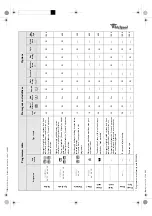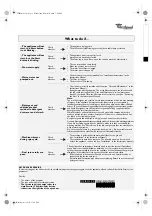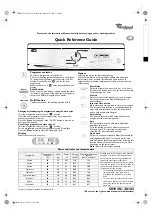
What to do if...
...The appliance will not
start, the Start button
is not blinking:
Check
whether:
• The appliance is plugged in.
• The wall socket is functioning correctly (use a table lamp or similar).
...The appliance will not
start, but the Start
button is blinking:
Check
whether:
• The appliance door is properly closed.
• A programme has been selected.
• The water tap is open. If not, open the tap and press the Start button.
...No water supply:
Check
whether:
• The tap is turned on completely.
• Kinks are present in water hose.
• The water hose filter is clogged.
• The water hose is frozen up.
...Waste water not
pumped out:
Check
whether:
• The drain hose is correctly installed (see “Installation Instructions” in the
Instructions Manual.
• The filter is clogged.
• The drain hose is frozen up.
...Detergent and
additive product
residues in detergent
drawer at end of wash:
Check
whether:
• The siphon is correctly installed and clean (see “Care and Maintenance” in the
Instructions Manual).
• Enough water is being supplied. The mesh filters between the inlet hose and
the tap could be clogged (see “Care and Maintenance” in the Instructions
manual); check and clean the filter two or three times a year (see “Removing
the filter” in the Instructions Manual).
Note:
Too much detergent can result in excess foam formation, which reduces washing
efficiency. If the appliance detects excessive foam it may prevent spinning.
Insufficient detergent may result in grey laundry, deposits on the drum, tub and
heater. To prevent dispensing problems when using highly concentrated powder
and liquid detergents, use the special detergent ball or bag supplied with the
detergent and place it inside the drum.
Whitish residues on dark fabrics are caused by insoluble compounds used in
modern phosphate-free powder detergents. If this occurs, shake or brush out
the fabric or use liquid detergents.
Keep detergents and additives in a dry place and out of reach of children.
Use only detergents and additives specifically produced for domestic washing machines.
If you use descaling agents, dyes or bleaches, make sure they are suitable for
washing machine use. Descaler could contain components that can attack parts
of your washing machine.
Do not use any solvents (e.g. turpentine, benzine, etc.). Do not machine wash
fabrics that have been treated with solvents or flammable liquids.
...Machine vibrates
during spin cycle:
Check
whether:
• The machine is perfectly horizontal with all four feet on ground
(see “Installation” in the Instructions Manual).
• The transit bolts have been removed. The transit bolts must be removed
before the appliance can be used (see “Installation” in the Instructions manual).
...Final spin results are
poor:
Check
whether:
The appliance has an imbalance detection and correction system. If individual
heavy articles are loaded (bathmat, bathrobe, etc.) this system may reduce the
spin speed automatically to protect the appliance or even interrupt the spin cycle
altogether, if the imbalance is too great even after several spin starts.
• If the laundry is still too wet at the end of the cycle, add smaller articles of
laundry and repeat the spin cycle.
• Excessive foam formation may also prevent spinning. Ensure correct amount of
detergent is used.
AFTER SALES SERVICE
If, after carrying out the above checks, the malfunction persists or appears again, turn the appliance off and call our After-Sales Service (see
guarantee).
Specify:
• The nature of the problem
• The type and model of washing machine
• The service code (the number after the
word Service). The After-Sales Service
sticker is on the right side of the open door.
3GB20103.fm Page 3 Wednesday, March 10, 2004 7:04 PM
Black process 45.0° 150.0 LPI






















